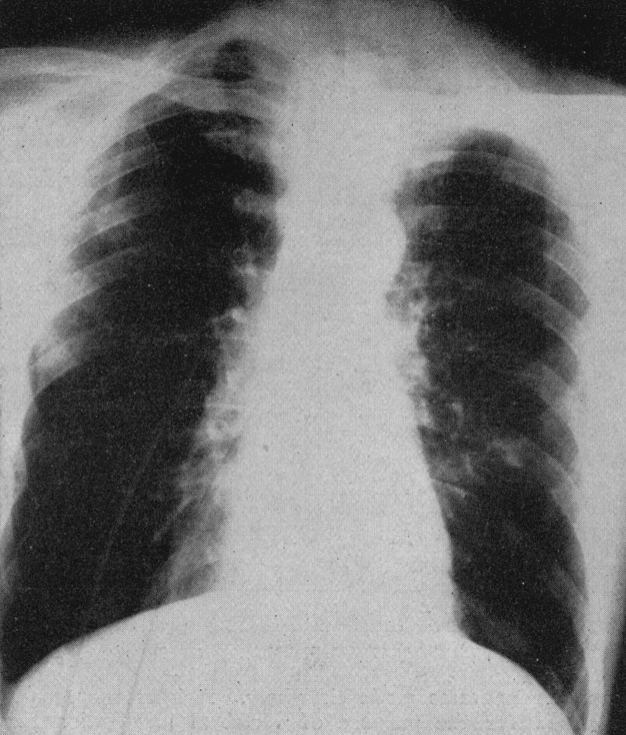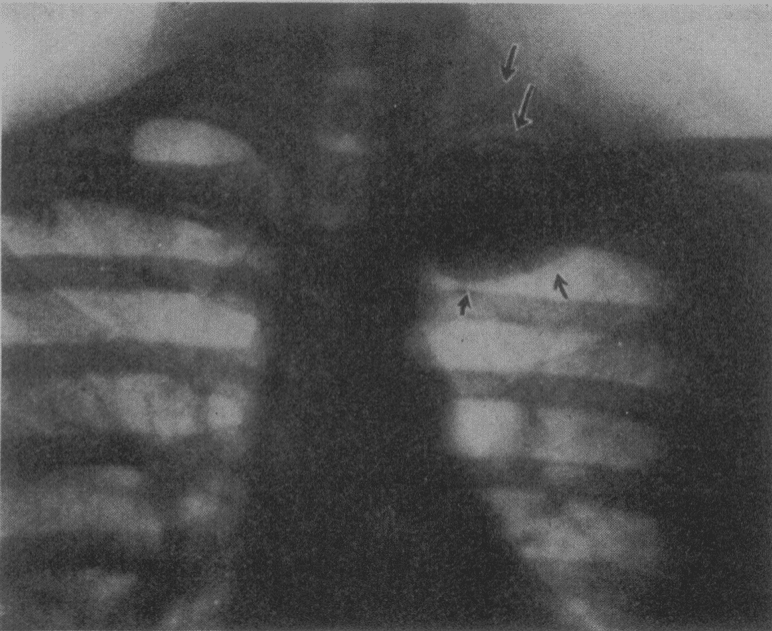Pancoast Syndrome
Description
Pancoast Syndrome occurs secondary to local compression of brachial plexus and sympathetic chain by superior (pulmonary) sulcus tumors. Associated tumors are usually non-small cell lung cancer (NSCLC) and interchangeably referred to as Pancoast Tumours.
Syndrome consists of:
- Shoulder pain: initially localised to shoulder and vertebral border of scapula)
- Radicular pain C8-T2: Progressive ulna nerve distribution pain and muscular atrophy
- Horner syndrome: present in 25% of presentations of Superior sulcus tumors. Extension of neoplastic invasion/compression to involve sympathetic chain and stellate ganglion
Example Cases: CXR Case 064 – CXR Case 069 – Befuddler 025
History of Pancoast Syndrome
1838 – British surgeon Edward Selleck Hare (1812-1838) described the case of a man who had died of a tumour on his neck. He had for some time before death exhibited marked constriction of the left pupil and drooping of the Levator palpebrae sutperioris. Hare was the first clinical observer to record the existence of what is now termed “Horner syndrome” in association with a cervical lesion.
1912 – Publio Ciuffini, published a case of primary cancer of the apex of the right lung. He drew the clinicians’ attention to a complex of symptoms which he believed to be characteristic. Symptoms consisted of paresis, paraesthesia, and pain in the ipsilateral arm due to compression of the brachial plexus; ipsilateral ptosis, enophthalmos and miosis; and finally compression of the subclavian artery and vein.
Imponenti furono anche in questo paziente i fenomeni di compressione , esercitati sugli organi vicini: primo a risentire gli effetti di essa fu il plesso brachiale dello stesso lato, a cui seguì, dopo molto tempo, la paralisi unilaterale del ricorrente, la quale in seguito divenne bilaterale, rendendo completamente afono il malato. Ad essa si unirono, un mese prima della fine, gli effetti della lesione della 8th radice cervicale e della l” dorsale, la quale ebbe la sua espressione in quel ristringimento della rima palpebrale destra, in quel l’enoftalmo, nella miosi della pupilla, nella mancanza del riflesso al dolore.
Ciuffini P. Sul cancro primitivo del polmone. 1912
The compression phenomena exerted on nearby organs was impressive in this patient: the first to show the effects was the brachial plexus of the same side, followed, after a long time, by the unilateral paralysis of the recurrent laryngeal nerve, which later became bilateral, making the patient completely mute. It was joined, a month before the end, by the effects of the lesion of the 8th cervical root and of the 1st dorsal, clinically manifest with right eye ptosis, enophthalmos, miosis, and lack of pain reflex.
Ciuffini P. Sul cancro primitivo del polmone. 1912
1924 – Henry Khunrath Pancoast (1875-1939) described three cases of localised apical lung tumors with neurological findings
Case 1: A man, aged 52, was admitted to the University Hospital early in September, 1921. His chief complaint was intense burning pain, high in the left axilla and extending down the arm, worse at night and keeping him awake. It was then of eleven months’ duration, at first intermittent and later continuous; limited to the shoulder girdle at first, but later referred down the arm to the elbow, and for the last two months to the wrist, during which time there was an associated muscular twitching, increasing weakness of the grip and muscular wasting of the hand.
On admission, there was noted a contracted left pupil, enophthalmos and narrowing of the palpebral fissure.
Pancoast 1924


Fig. 3 (case 7).—Roentgenogram of the chest, showing the circumscribed apical shadow. Note the upper arrows pointing to the second rib and to the head and neck of the first rib, both of which are intact. Pancoast 1932

Associated Persons
- Publio Ciuffini
- Henry Khunrath Pancoast (1875-1939)
- Johann Friedrich Horner (1831-1886)
Alternative names
- Superior Sulcus Tumour; Pulmonary Sulcus Tumor
- Pancoast’s Tumour; Pancoast’s disease
- Tobías syndrome
- Ciuffini-Pancoast-Tobías syndrome; Ciuffini-Pancoast syndrome
References
Original articles
- Hare ES. Tumor involving certain nerves. London Medical Gazette, 1838/39; 2(1): 16-18.
- Ciuffini P. Sul cancro primitivo del polmone. Il Policlinico. Sezione medica. 1912; 19: 67-85
- Pancoast HK. Importance of careful roentgen-ray investigation of apical chest tumors. Journal of the American Medical Association, Chicago, 1924, 83: 1407
- Pancoast HK. Superior pulmonary sulcus tumor. Tumor characterised by pain, Horner’s syndrome, destruction of bone and atrophy of hand muscles. Journal of the American Medical Association,1932, 99: 1391-1396
- Tobías JW. Sindrome ápico-costo-vertebral doloroso por tumor apexiano. Su valor diagnóstico en el cáncer primitivo pulmonare. Revista medica Latino-americana, Buenos Aires, 1932; 17: 1522-1557.
Review articles
- The Pancoast Era – University of Pennsylvania [PDF Full text]
- Arcasoy, SM. Jett, JR. Superior Pulmonary Sulcus Tumors and Pancoast’s Syndrome N Engl J Med 1997; 337:1370-1376
eponymictionary
the names behind the name
